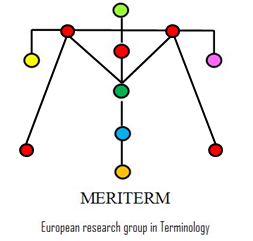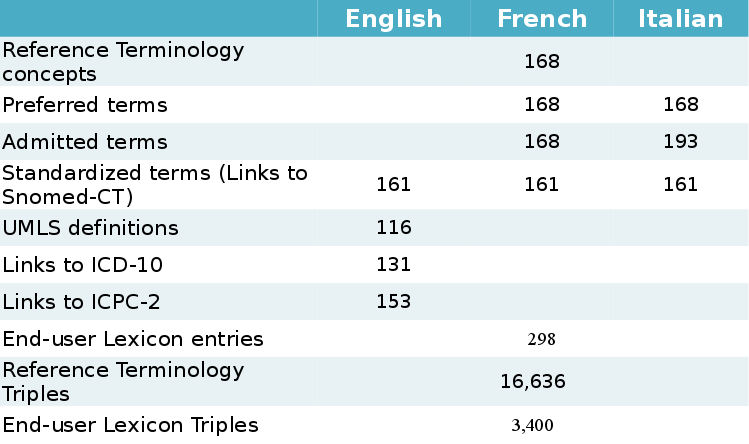
About
MERITERM is a consortium devoted to joined research activities on
medical terminologies and classification systems.
MERITERM stands for Medical Enduser and Reference Interface
Terminology.
The project aims to identify an extensive but well delineated core set of
meanings of words and phrases, commonly used in medical communication in a
number of key languages. In addition, it aims to build an interface terminology
for human/machine and human/human interaction (medical specialists, general
practitioners, allied health professionals, pharmacists and patients). This
core set will be linked to large existing linguistic resources, as available
in many languages, and to a broad array of international medical
classifications.
It involved so far researchers from:
Contact us
Approach
The principles of the approach are the following:
- To work with ISO norm and W3C standards where ever possible.
- To split the interface terminology in two intertwined resources:
- a. The end-user terminology: A lexical resource in LMF (one per language)
to capture words and phrases commonly used in medical communication and
to manage their linguistic properties (part of speech), polysemy,
synonyms, acronyms and variants. Implemented with the Lemon framework.
- The reference terminology: A conceptual resource in TMF (multilingual) to
define the concepts behind specific meanings of words and phrases, and
to map these concepts to international (mostly English)
classifications, nomenclatures and thesauri.
- To limit the number of concepts in the reference terminology to a core set
of less than 15.000 entries (for pragmatic reasons), yet providing core
concepts for general practitioners, various medical specialists, allied
health personnel, as well as for patients. Such an approach allows us to
control the size and thus the maintainability of a reference terminology while
promoting the independent existence of nomenclatures, terminologies,
glossaries, specialized glossaries whose evolution will not be hampered by a
resource which tries to include everything, at the risk of becoming
unmanageable.
- To map to SNOMED-CT and UMLS as reference nomenclatures, wherever
possible.
- To map in addition to all relevant classification systems such as
International Classification of Primary Care (low granularity, reason
for encounter-oriented) and International Classification of Diseases
(high granularity, disease-oriented), to thesauri such as Medical Subject
Headings (MeSH), and to other resources such as LOINC, ATC, NANDA, ICF,
...
- To link the end-user terminology to existing natural language processing
(NLP) resources or lexicons, such as WORDNET, where ever possible and
to local nomenclatures.
- To provide these resources as Linked Data on the Internet, under a Common
Creative License. The technical decision to publish it as Linked Data
provides the opportunity to link the reference terminology with other
useful resources, and to let interested third parties link to the reference
terminology.
The principles of this approach were developed as recommendations by the
Heymans Institute of Pharmacology, University of Ghent, in a small, initiating
project, commissioned by the Belgian Medical Informatics Association (MIM), on
behalf of the Belgian Health Department.
The report was published as:
Roumier J, Vander Stichele R. Analysis of the application of the ISO
16642 norm Terminological Markup Framework (TMF) for the Belgian
Reference Terminology. Report to the Belgian Medical Informatics
Association, October 28, 2011.
Results
In addition to terminological and lexical models, the Meriterm
project has carried out several small scale implementations of the approach.
The following table summarizes them:

Resources
The terminology is published on the DataHub Meriterm
repository
The lexicon is available here.
References
Publications
- Roumier J, Vander Stichele RH, Romary L, Cardillo E. Approach to the Creation of a Multilingual, Medical Interface Terminology. Proceedings of the 9th International Conference on Terminology and Artificial Intelligence (TIA2011). Workshop 2 on “Ontology and Lexicons: new insights”. November 15, 2011, Paris. Available from: https://hal.inria.fr/hal-00646223_v1/
- Roumier J, Jamoulle M, Vander Stichele RH, Romary L, Cardillo E, Vander Stichele RH. Towards a terminologies support system in Primary Care [Letter to the editor]. Informatics in Primary Care. 2011;19:257–8.
- Jamoulle M, Vander Stichele RH, Roumier J, Cardillo E. Analysing terms of a narrative family medicine guidelines using ICPC, ICD, SNOMED-CT and UMLS. WICC meeting 2012, Ravello, Italy [Internet]. 2012. (also presented at Patient Classification Systems International 2012 Avignon, France). Available from: http://www.ph3c.org/PH3C/docs/27/000267/0000390.pdf
- Vander Stichele RH, Jamoulle M, Cardillo E, Roumier J, Romary L, van Nimwegen E, Warnier M. A combined onomasiological and semasiological approach to the development of a comprehensive interface terminology for information storage and retrieval in primary health care. Presented at Patient Classification Systems International, CISP Club 2012, Avignon, France. Available from: https://hal.inria.fr/hal-00769199
- Warnier M, Roumier J, Jamoulle M, Vander Stichele RH, Romary L, Cardillo E. Publishing a Multilingual Medical Terminology According to Terminology Standards and Linked Data Principles. Monnet Challenge 2012. 2012.
- Cardillo E, Warnier M, Roumier J, Jamoulle M, Vander Stichele RH. Using ISO and Semantic Web standards for creating a Multilingual Medical Interface Terminology: A use case for Heart Failure. To be published in Proceedings of the 10th International Conference on Terminology and Artificial Intelligence (TIA2013). October 28, 2013.
- Jamoulle M, Vander Stichele RH, Cardillo E, Roumier J, Warnier M.
Mapping French terms in a Belgian guideline on heart failure to
international classifications and nomenclatures: the devil is in the
detail. Inform Prim Care. 2014;4(189-198).
doi


